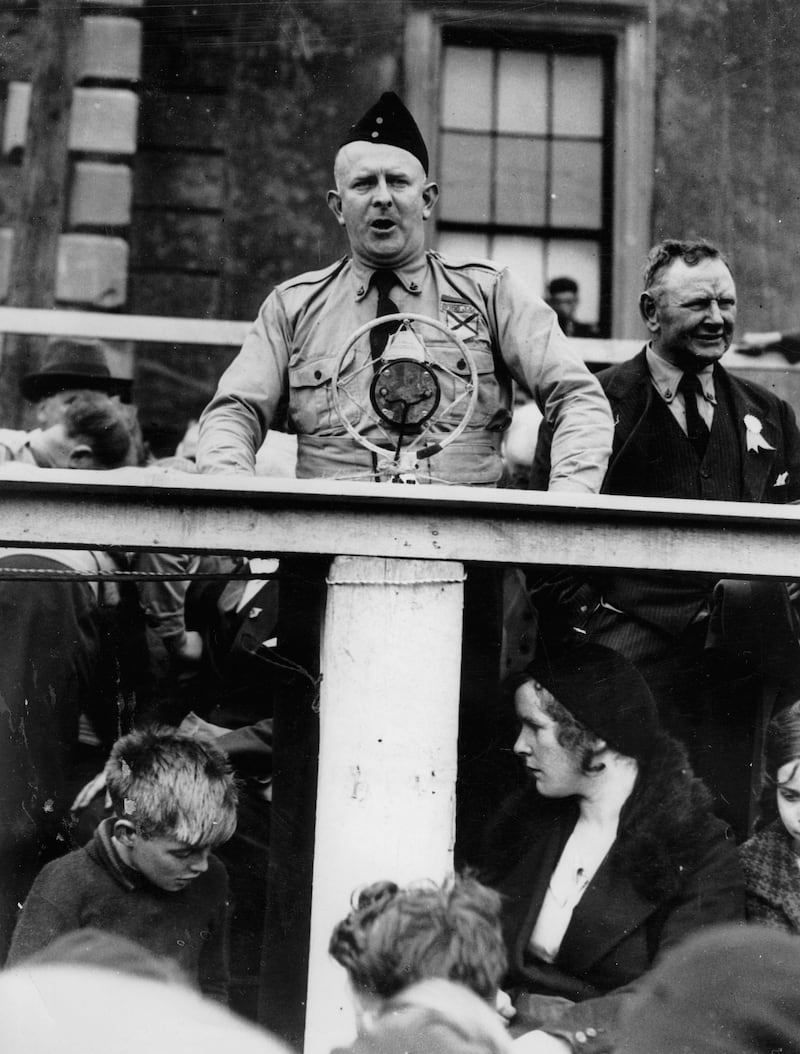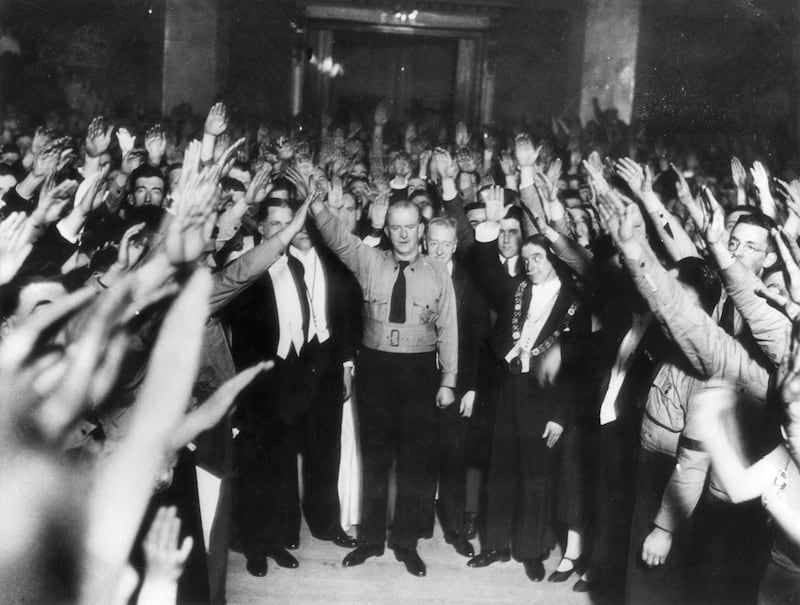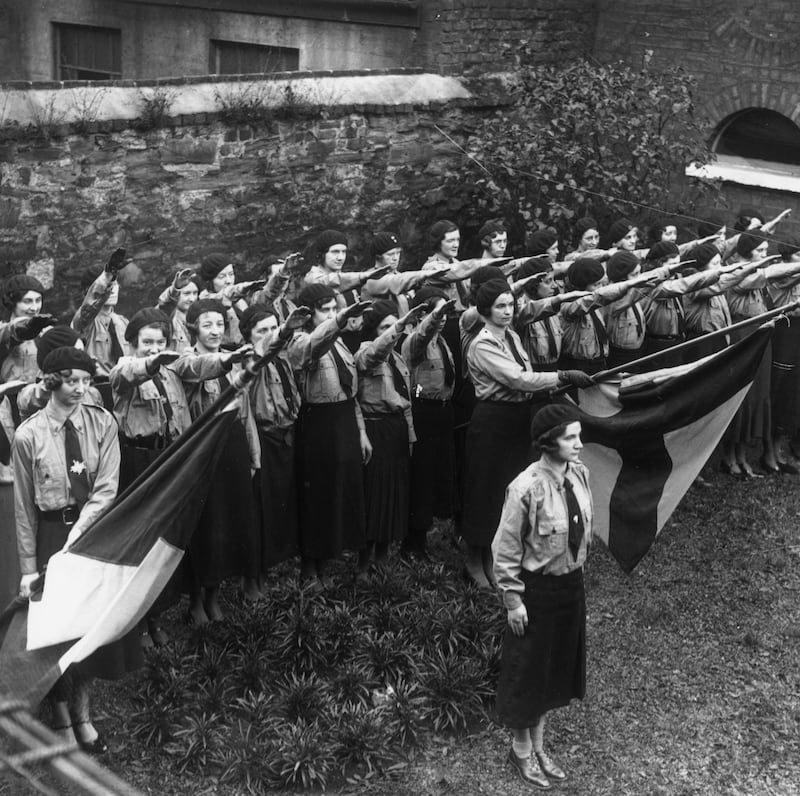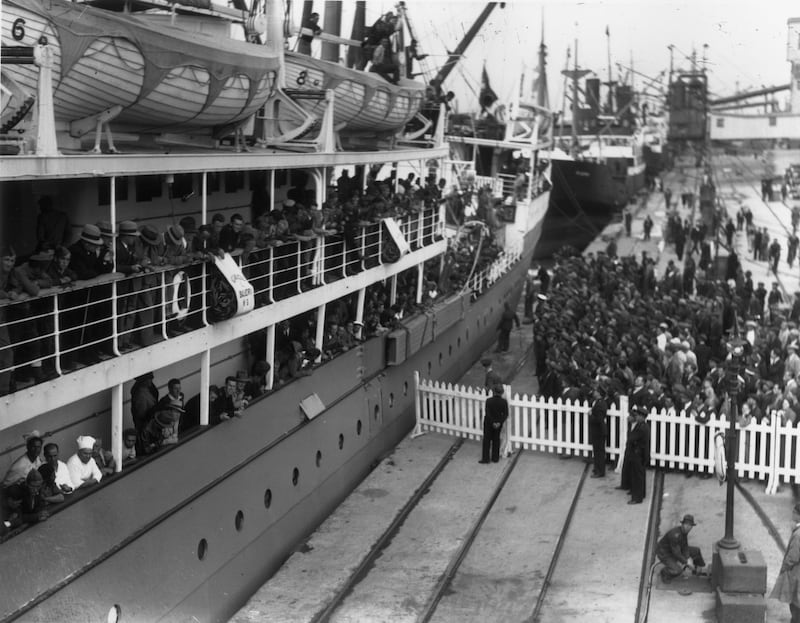Eoin O’Duffy had an unremarkable childhood. Born Owen Duffy, he was the son of an impoverished farmer. His self-serving unpublished autobiography paints a picture of a relatively happy childhood in Co Monaghan, one that was framed by the Catholic religion and tradition and a happiness derived from time spent outdoors, in communion with the land.
O'Duffy did not come from a political family; he made his name in nationalist circles through his involvement with the GAA. In this he had something in common with Michael Collins.
But while Collins is revered in Fine Gael circles, any mention of O'Duffy – the party's first president – is studiously avoided. This stems from his leadership of the Blueshirts, an organisation popularly viewed in the same category as the fascist movements that swept swathes of inter-war Europe.
The role that O'Duffy played, and the involvement of his organisation, in the creation of Fine Gael is one that the party regularly and purposely overlooks
Consequently, the role that O’Duffy played, and the involvement of his organisation, in the creation of the party is one that is regularly and purposely overlooked by Fine Gael.
Fine Gael was created in 1933 to challenge Fianna Fáil at a time when the opposition, independently, seemed incapable of doing so. By the time of the 1932 election, when Fianna Fáil first took power, Cumann na nGaedheal had every appearance of a party that was worn out after a decade of continuous governance.
Talk of the need for a new national party grew, instigated by Senators Arthur Vincent and Alfie Byrne, who envisaged Cumann na nGaedheal and the National Centre Party (led by Frank MacDermot, with its roots in the National Farmers’ and Ratepayers’ Association) joining together in a reconfigured political landscape before the 1933 election.
They were slow to do so, until Fianna Fáil unwittingly provided the impetus for the formation of a new party. It was in this context that the Blueshirts were significant.
The Blueshirts came into existence in 1932 as the Army Comrades' Association, formed to offer support to ex-servicemen. It counted among its ranks the leading Cumann na nGaedheal politicians Ernest Blythe, Patrick McGilligan and Desmond FitzGerald. Despite having TDs who sought re-election among its membership, the organisation claimed it was non-political.
However, its independence was called into question when the Army Comrades’ Association became closely associated with Cumann na nGaedheal, and the Centre Party during the 1933 election campaign. That campaign was punctuated by attacks and clashes, and Cumann na nGaedheal candidates, as well as those from MacDermot’s party, were routinely targeted. The Army Comrades’ Association extended its services to protect the meetings.
The uniform with blue shirt was adopted at a meeting three months after the election, in April 1933. Connections were immediately drawn with Hitler’s Brownshirts and Mussolini’s Blackshirts.

Certainly, de Valera interpreted the Blueshirts as Cosgrave had the IRA. The Fianna Fáil government moved to circumvent any risk.
On the weekend of July 29/30th, Patrick McGilligan, Ernest Blythe and J.M. O’Sullivan had their licences to possess firearms revoked. Blythe had carried his State-owned revolver only since 1927, acquiring it for protection after Kevin O’Higgins’s assassination. Not only were all three men prominent members of the National Guard, as the Blueshirts were now called, but they had also been key members of the Cumann na nGaedheal government.
While others had their licences withdrawn too, the targeting of former government members appeared calculated. From August 1st the operation to disarm other members of the National Guard moved quickly. Tensions mounted, and the Garda presence at Government Buildings was stepped up. The threat of violence hung in the air.
Despite the increasingly acrimonious atmosphere, O’Duffy persevered with a plan for the annual commemoration of Arthur Griffith, Michael Collins and Kevin O’Higgins. Though scaled back compared with previous years, such a gathering had the potential to descend into violence. It was perceived as a “‘march on Dublin”, a reference to Mussolini’s march on Rome.
O'Duffy had emerged as one of the leaders of the republican movement through his association with the GAA
On August 22nd 1933 de Valera’s government invoked article 2A of the constitution, banned the parade, and proclaimed the National Guard illegal.
De Valera’s use of this instrument to deal with the National Guard concerned Frank MacDermot, who became more open to the idea of strengthening the opposition. At this point O’Duffy was invited into the discussions. An isolated and illegal organisation, with little hope of a future, the National Guard needed respectable allies.
The organisation's executive approved the motion to join with Cumann na nGaedheal and the Centre Party on September 8th. The National Guard was later reconstituted as a new organisation within Fine Gael, named the Young Ireland Association.
Subsequent talks resulted in the creation of the United Ireland Party – Fine Gael, to be simply known as the United Ireland Party. This was at the insistence of Frank MacDermot, who was reported to have floated “United Ireland” at the outset of the discussions and had stood firm thereafter.
For MacDermot, this name was an important signifier to voters about the new party’s priorities, reflected also in the first point of the Fine Gael manifesto, which spoke of the need for national reunification. Michael Tierney suggested “Fine Gael”.
The choice of an Irish name was important symbolically, and it also represented continuity with Cumann na nGaedheal. The “organisation of the Irish” was thus to become the “family of the Irish”. The succinct name was also snappier than MacDermot’s wordier title, and it tripped off the tongue more easily.
It’s hardly surprising that “United Ireland” was virtually dropped within months and that Fine Gael was was more commonly used. The disappearance of MacDermot’s preference coincided, not uncoincidentally, with his own decision to withdraw from the party.
If it had not been for the final phase of his public life, when O'Duffy openly embraced fascism, he would have been remembered as a patriot and state-builder
If Fine Gael was to be constructed and accepted as a new party, it also needed a new leader – one who was free of political baggage. That ruled out both Cosgrave and MacDermot. That left O’Duffy.
Why was the man described by his biographer as one of the most egregious figures of modern Ireland chosen to lead Fine Gael?
It is important to remember that, if it had not been for the final phase of his public life, when O’Duffy openly embraced fascism, he would have been remembered as a patriot and state-builder. It was precisely that reputation in 1933 that allowed him to claim the presidency of Fine Gael.
O’Duffy had emerged as one of the leaders of the republican movement through his association with the GAA.
Similarities between his drive and organisation work in the GAA and later with the IRA have been observed, the former providing the training ground for the latter. O’Duffy attributed his decision to join the Irish Volunteers to his involvement with the GAA and his advancement within the Volunteers owed much to his role in the GAA, providing him with a rich recruitment pool. By 1918 he had become a driving force behind the IRA nationally, touring the country, organising and reorganising.
His arrest that year confirmed his credentials in republican circles. On his release he played a key role in the independence struggle, marking himself out as one of the most effective IRA leaders in Ulster. When the IRA was reorganised in 1921, O’Duffy was appointed to GHQ as director of organisation, an influential post previously held by Collins. This placed him at the nerve centre of IRA operations.
Such prominence later helped facilitate O’Duffy’s work managing the expectations of rank-and-file members in the aftermath of the Truce and subsequently convincing them to support the Treaty settlement. He shared Collins’s view that the Treaty would be a stepping-stone towards a republic.
Following Collins’s assassination in August 1922, Kevin O’Higgins – in his role as minister for home affairs – sought to appoint O’Duffy as commissioner of the Civic Guard.
Taking up the post in September 1922, he was tasked with building the force that would later become the Garda Síochána, tackling discipline and ensuring an ethos in line with the aims of the new State. He held the post until 1933, when he was controversially dismissed by the de Valera government – before he was connected with the Blueshirts.

Before his descent into fascism O’Duffy had moved in the right circles, had proved his abilities, and was both respected and trusted by many of his peers – although W.T. Cosgrave was a notable exception.
While he inevitably upset some people along the way, the decision to appoint him first president of Fine Gael was not a problematic one at the time. He was seen by contemporaries as an energetic and somewhat charismatic figure, a man with an “unimpeachable character and an unassailable record”, according to an editorial in the Kilkenny People.
Fine Gael issued a six-point statement to the press on September 8th 1933, followed by a more detailed 25-point programme onNovember 11th, before the 1934 ard-fheis. Although the influence of Frank MacDermot can clearly be seen in both documents, their content ultimately – and not surprisingly – represented continuity with much of Cumann na nGaedheal’s previous policies.
The position on Northern Ireland remained unchanged; plans for tackling unemployment were similar; and reform of the voting system also featured. The most obvious difference was the proposal for the establishment of industrial and agricultural corporations.
Opponents and commentators were quick to claim that Fine Gael was simply a rebranded Cumann na nGaedheal. As the Labour leader William Norton colourfully put it, “the new move was an attempt to put old wine in new bottles”.
In the decades since 1933, this notion of continuity has been perpetuated, with politicians such as Seán MacEntee, Fianna Fáil minister for health, claiming that “the sins of the Cumann na nGaedheal are the sins of Fine Gael”.
There have been references in the Dáil and Seanad to Cumann na nGaedheal’s reduction of teachers’ salaries, alleged patronage, perceived responsibility for partition, unemployment, and neglect of social services, as well as numerous mentions of Ernest Blythe’s notorious pension cut, among other political sins – all reintroduced into political debate for the purpose of point-scoring against the Fine Gael party of the day.
He encouraged calls of "Hoch O'Duffy", deliberately imitating the German greeting Heil Hitler
By far, though, the quickest and easiest way to antagonise a Fine Gael politician or supporter is to invoke the Blueshirts. In recent years there has been something of an attempt by party members to reclaim the term, self-labelling themselves in a playful, light-hearted way. Nonetheless it remains a useful slur to be employed by critics.
Were the Blueshirts Ireland’s fascists? The nature of the movement has been the subject of much debate. The very name immediately evokes thoughts of Mussolini’s Blackshirts in Italy and Hitler’s Brownshirts in Germany. Plenty of photographic evidence exists of blueshirt-wearing members raising an arm in the style of the Nazi salute. But drawing comparisons with European fascist movements – and their shirted uniform in particular – both helps and hinders our understanding of the Irish movement.
The liturgical element of the Blueshirts – a defining component of fascist movements – was highly developed. The choice of colour for the uniform, adopted at the suggestion of Ernest Blythe, was deliberate. Blue is attributed to Ireland’s patron saint, and its use connected the movement to the country’s historical mythology.
O’Duffy claimed that at its height the movement had 100,000 members; the actual figure is more likely to have been half that. Styling himself the “third most important man in Europe”, O’Duffy provided the scope for the cult of the leader that is central to fascism. He encouraged calls of “Hoch O’Duffy”, deliberately imitating the German greeting Heil Hitler.
Clearly, then, the Blueshirts possessed certain fascist traits, influenced by developments on the Continent. This was certainly how the organisation was perceived by opponents at the time.

Responses such as that by John A. Costello helped compound such views. He declared that the Blackshirts were victorious in Italy and . . . the Hitler Shirts were victorious in Germany, as assuredly . . . the Blueshirts will be victorious in the Irish Free State.
Prominent members, such as Tierney, Hogan, Blythe and Desmond FitzGerald, also all expressed undisguised admiration for Mussolini. But, as the historian Mike Cronin has emphasised, it is important to acknowledge that the Dáil and the Seanad featured in the Blueshirt vision for a restructured Irish State. It was never intended that parliamentary democracy be disestablished (although some members – in the minority – did imply this). It is on this point that the Blueshirt ideology diverged from its Continental counterparts, making it a para-fascist organisation.
Under O'Duffy's direction, dances, cycling excursions, picnics, sports days, Gaelic football, hurling and boxing matches were organised throughout the country
There was another side to the Blueshirts: the sports and social gatherings. In the context of rural Ireland at that time, social gatherings offered a release from an otherwise mundane life.
Under O’Duffy’s direction, dances, cycling excursions, picnics, sports days, Gaelic football, hurling and boxing matches were organised throughout the country. The appeal was obvious, particularly for younger residents of rural communities.
If the Blueshirts are best understood as para-fascists, what of Eoin O’Duffy? His leadership of Fine Gael had a promising start. Meetings were held around the country and greater attention was paid to the branch structure than had been the case during the Cumann na nGaedheal era.
By March 1934 an energetic O’Duffy had spoken at meetings in 23 of the 26 counties; increasingly these became Blueshirt rallies, with the right-arm salute a growing feature.
Any early promise O’Duffy showed of being the next Michael Collins was not borne out. On reflection, this promise was really the product of his own invention – an example of his predilection for self-aggrandisement. Of his contemporaries, Mussolini and Franco offer more useful parallels in terms of personality and politics. Flawed figures, plagued by insecurity and a hunger for adulation, they wrote and rewrote their personas.

The Wearing of Uniforms (Restriction) Bill was introduced by the minister for justice, Patrick Ruttledge, in 1934 to outlaw the Blueshirt uniform after some Fine Gael politicians began wearing it in the chamber. Badges, banners and military titles that were considered at odds with public peace would also be prohibited. But the bill never became an act. After an acrimonious debate in the Dáil, the Seanad rejected the proposal by 30 votes to 18. The bill was suspended for a period of 18 months, but by then the perceived Blueshirt threat had receded.
O’Duffy faced his first electoral test as Fine Gael president at the 1934 local elections. It was an opportunity to show that the new party had attracted strong support and that the government’s efforts to ban the Blueshirts were unpopular. Contesting the elections also made a break with Cumann na nGaedheal tradition; Cosgrave’s party had not attached importance to contesting such elections.
The results revealed O’Duffy’s political naïveté. Having forecast that the party would take control of 20 out of the 23 councils, Fine Gael won control of only six.
Thereafter, a new note of extremism crept into O’Duffy’s speeches. In particular, his call for farmers to withhold payment of land annuities sat uneasily with Fine Gael colleagues. Such an open call of defiance was difficult to reconcile with the image of Fine Gael as a constitutional party, and leading members were resistant to O’Duffy’s proposition that non-payment should be adopted as official Fine Gael policy.
As O'Duffy's extremism grew, it was those members of the Blueshirts who were dedicated to democracy who worked to remove him from the Fine Gael leadership
As O’Duffy’s extremism grew, it was those members of the Blueshirts who were dedicated to democracy – most notably Blythe, Tierney and FitzGerald – who worked to remove him from the Fine Gael leadership. With his growing embrace of fascist ideology, O’Duffy was a leader that a democratic political party, one that prided itself on commitment to law and order, could not afford.
Talks took place between O’Duffy, Cosgrave, Dillon and Cronin, all of which were held in secret, breeding speculation, rumours and counter-claims about what occurred. Ultimately O’Duffy resigned at a meeting of the party on September 21st. Members had not been forewarned, though the announcement can hardly have come as a surprise.
O’Duffy had essentially been stage-managed out of the presidency. He succumbed to cultural extremism long before fascism, seeing his role while Garda commissioner not just as law enforcement but also as a defender of morality. Although his fascist views were evident then, it was only after he departed from Fine Gael that he gave full expression to them.
His departure left a vacancy that Fine Gael was not quick to fill. Cosgrave, as the de facto leader of the party in the Dáil and the most experienced politician in the parliamentary party, was an obvious choice. That a conscious decision was taken to delay appointing a successor until the ard-fheis, scheduled for March 1935, implied a lack of enthusiasm about Cosgrave resuming duties. When the party gathered on that occasion, Cosgrave was unanimously selected as O’Duffy’s replacement.
The Blueshirts may have dominated the political scene for about two years, and they had been a critical part of the merger that created Fine Gael, temporarily overshadowing the party, but once O’Duffy was removed from the presidency and the principles of fascism were rejected, the movement petered out, collapsing in on itself.
O'Duffy is too problematic to ever feature in any form of official commemoration. The ease with which "Blueshirt" can be used as a term of abuse has left party members shy about engaging with their first president
The organisation's legacy to Fine Gael, however, is disproportionate to its involvement with the party. Opposition TDs continue to gleefully use the Blueshirts to taunt Fine Gael deputies. When Leo Varadkar criticised Sinn Féin for holding rallies after the 2020 election, some people took to Twitter to share pictures of Blueshirt rallies.
It is hardly surprising then that Fine Gael chooses to play down this element of its history, opting instead to highlight the heroic Michael Collins, whose assassination at the age of 31 sealed his fate as a patriot and an icon. This is a problematic, selective interpretation of the party’s history. Collins was dead almost eight months before Cumann na nGaedheal was founded and more than a decade before Fine Gael was created.
But O’Duffy is too problematic to ever feature in any form of official commemoration. Although he was a complex figure – someone who had all the makings of a patriot – the ease with which “Blueshirt” can be used as a term of abuse has left party members shy about engaging with their first president.
Claiming continuity with Collins or Cumann na nGaedheal is a convenient way for Fine Gael to sidestep any need to confront the reality that Eoin O’Duffy – the man indelibly linked with the Blueshirts – was the party’s first president. Without the Blueshirts, however, there might not have been a Fine Gael.
This is an edited extract from Saving the State, by Ciara Meehan and Stephen Collins, published by Gill













